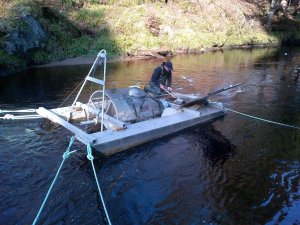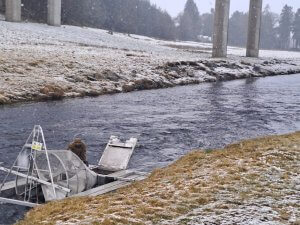PUBLISHED: 09/04/24


Findhorn, Nairn and Lossie Rivers Trust
PUBLISHED: 09/04/24
Installation and Operation of the Rotary Screw Trap on the River Findhorn.
We are grateful to have received funding as part of our Findhorn Watershed Initiative to run a trial of the FDSFB smolt trap at Tomatin this spring. Below our resident biologist, Bob Laughton, expands on this element of the project and what we hope to gain from the trial.
Background
The development of portable Rotary Screw Traps a few decades ago has helped make monitoring salmon smolt runs more affordable. The Rotary Screw Trap (RST) trap shown below in action on the River Divie, consists of a central drum which is suspended between two floats. The drum faces upstream and is turned by the river flow and, if positioned well, will catch a good sample of downstream migrating salmon and trout smolts. The smolts are retained in a holding box at the rear of the trap and each morning the fish are counted, measured and released to continue their seaward migrations. The smolt run typically last around 4 to 6 weeks during April and May each year. The Findhorn District Salmon Fishery Board purchased a RST in 2018 and have operated it in the lower Findhorn and the River Divie, collecting data on smolt numbers and also tagging a portion to look at their migration routes and survival as part of the Atlantic Salmon Trusts Missing Salmon Project.

Photo: Smolt trap on River Divie courtesy of Bob Laughton
This year we plan to move upstream to trial a trap near Tomatin. The main purpose will be to see if the trap can be operated there for several years to provide information on the salmon and trout smolt runs from the upper river.
Timetable
The trap was installed at the beginning of April. It is not clear how long the trial will run, it may depend on how suitable the site turns out to be.

Photo: Smolt trap at Tomatin courtesy of Sean McLean
Data Collection, Trap Operation and Staffing
Smolt runs generally peak in April/May although it can vary depending on winter temperatures and flow rates etc. The trap will be visited each morning, the captured fish will be identified, measured, a scale sample obtained from a selection before release back to the river further downstream.
Trap efficiency can be calculated from standard mark re-capture techniques and yearly estimates of smolt outputs developed. Mark recapture involves marking a portion of the smolt catch with a dye spot and releasing them upstream from the trap and determining the number re-captured.
Staffing and tagging will be managed by Bob Laughton (FNLRT), Sean Mclean (FDSFB) and Alister Taylor (FDSFB). Visitors to the trap are welcome and anyone wishing to volunteer to help with processing the fish will be very welcome. Please contact Bob or Sean for more details.
Bob Laughton : 07887 535986 director@fnlrt.org.uk
Sean Mclean : 07920 483081 sean@findhorndsfb.org.uk
Early Indications
Although, still in the early stages of the trial, numbers are looking good and in normal water conditions the trap is working well, however, trap position is proving to be difficult to manage during spate conditions and further tests are needed to determine if the site is suitable for the long term.
This project is supported by funding from:

